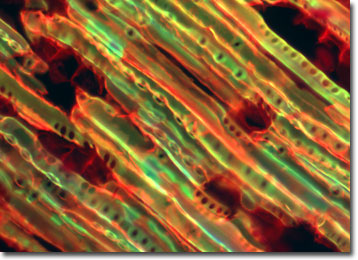Fluorescence Digital Image Gallery
Female Pine Cones
Pine is the common name for any species belonging to Pinus, a genus of the family Pinaceae, which consists of coniferous trees with needle-like leaves. Pinaceae is the largest family of conifers, consisting of about 262 species, and includes fir, larch, spruce, hemlock, and cedar.

Pine trees are gymnosperms, non-flowering plants that produce exposed seeds not enclosed in an ovary. They are also monoecious, bearing gametes of both sexes on the same tree. These gametes are housed in a structure called a strobilus, or cone. Female pine cones are generally found in the upper branches of the tree crown, above the male cone. This reduces the possibility of self-fertilization by the wind-borne male gametes.
The female pine cone, or megastrobilus, produces the ovule, or unfertilized seed. Scales (modified leaves) on the female cone open to receive pollen, then close. Fertilization takes place late the following spring. Over a two to three year period after fertilization, the woody female pine cone develops. In some species, the cones open at maturity and the seeds are released. In others the cones remain closed for several years until opened by rotting, by food-seeking animals, or by fire. In some pines the scale bearing the nut-like seed may be expanded to form a wing for airborne dispersal.
Some pine trees produce seeds, pine nuts (pignons, piñons, pignoli) that are popular in human cuisine. Although most nuts are technically fruits, pine nuts are not because they are not formed by a flowering plant. Piñons from pines in the western United States have historically been an important food source for Native Americans. The stone pine (P. pinea) in Italy has been prized since ancient Rome for its pignoli, which are still used for food.
Pine trees are found worldwide, primarily in northern temperate regions. Typically they have woody stems covered in bark, which protects tissues that conduct nutrients and water. When harvested, they provide materials like lumber, turpentine, rosin, paper, and pulp, fuel.
The specimen presented here was imaged with a Nikon Eclipse E600 microscope operating with fluorite and/or apochromatic objectives and vertical illuminator equipped with a mercury arc lamp. Specimens were illuminated through Nikon dichromatic filter blocks containing interference filters and a dichroic mirror and imaged with standard epi-fluorescence techniques. The filter combination utilized to image the female pine cone was a triple cube specific for DAPI, FITC, and Texas Red. Photomicrographs were captured with an Optronics MagnaFire digital camera system coupled to the microscope with a lens-free C-mount adapter.
BACK TO THE FLUORESCENCE DIGITAL IMAGE GALLERY
